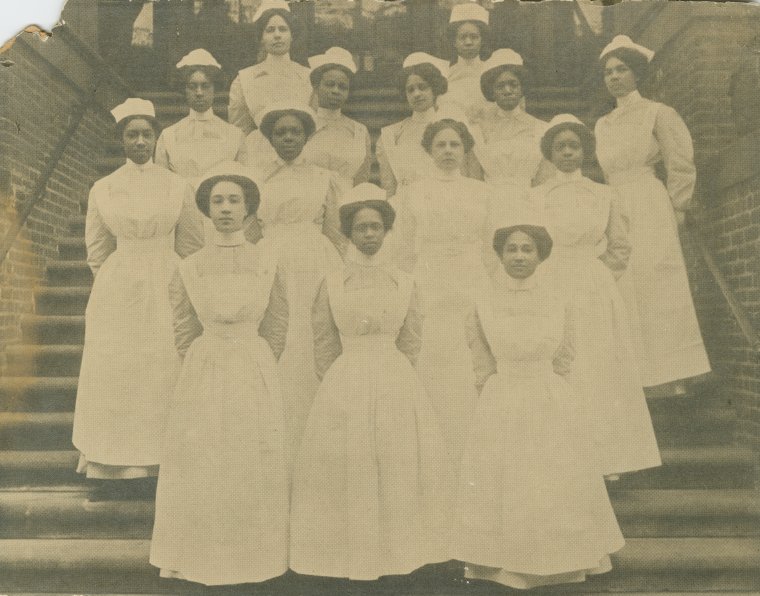NYC Neighborhoods, Africa and the African Diaspora
San Juan Hill and the Black Nurses of the Stillman Settlement

Black New York: In 1625, eleven enslaved Africans arrived in New Amsterdam to physically clear the land for what we now know as New York City. Some parts of New York, such as Harlem, are well-known black neighborhoods, but black people have lived in and impacted all parts of New York City for centuries. Let us take some time to explore the many areas of New York City where African Americans have lived and thrived, starting circa 1900 in an area then known as San Juan Hill…
Nurses without Patients
It was the early 1900s, Elizabeth Tyler, R.N. had the credentials, she just didn’t have any patients. Black women had long been the designated caretakers for both black and white communities, but it was only in the late 19th century when black women could actually study and earn their titles as registered nurses. Tyler, recently graduated from Freedmen’s Hospital Training School for Nurses and having completed an advanced course in nursing at the Lincoln School for Nurses, found that she was not allowed to treat white patients, and that the black patients didn’t trust her.
After leaving Lincoln, Tyler was quickly hired as the first black visiting nurse at The Henry Street Nursing Settlement by its founder, Lillian Wald. Born into a wealthy Jewish family, Wald was a progressive for her time (the first NAACP Convention was held in the Henry Street dining room) and she hired Tyler, but was unable to get any patients for her to treat. Taking matters into her own hands, Tyler traveled uptown to the black tenements of San Juan Hill to try to put her nursing education to use.

San Juan Hill
Around 1900, the African American population in New York was being pushed from the Lower East Side to farther uptown, settling in an area named San Juan Hill after a battle of the Spanish-American War. San Juan Hill covered the area of 40th Street to about 65th Street on the West Side of Manhattan, and at its peak 10,000 black people lived in this small section of New York. Today, an apartment in this area can rent for around $5,000 a month, but what was it like in the early 20th century for the largely black population that lived in San Juan Hill? According to an article in the New York Amsterdam News (which began in San Juan Hill):

The Stillman House Settlement
Nurse ElizabethTyler, finding many of the residents of San Juan Hill mistrustful of her, began to befriend the janitors that maintained the tenement buildings and through them gained access to the people who lived there. Knowing she would be more useful in the black neighborhood she asked Lillian Wald to support a Nurse’s Settlement for San Juan Hill, which she did. The new settlement, at 154 West 62nd Street, became the Stillman House, after Thomas Stillman whose daughter provided financial support.

What is a Settlement?
Settlement houses became popular in the late 19th century and slowly phased out in the 1920s (although some, like Henry Street, still exist). The purpose was to serve poverty-stricken areas with services such as health care, educational opportunities, arts, and other services.
The Impact of Stillman House

Resources
Clarke, J. H. (1976, Jun 26). Harlem -- A Brief History of the World's Most Famous Black Community. New York Amsterdam News (1962-1993)
Bulletin of the New York Public Library, Volume 18, page 336.
Davie, G. T. (1954, Jun 19). Better homes for Harlemites-- from San Juan to Sugar Hill. New York Amsterdam News (1943-1961)
Dodson, H. (2001). The Black New Yorkers: the Schomburg Illustrated chronology. New York: Wiley.
Editorial Comment. (1906). The American Journal of Nursing, 6(12), 829-842. Retrieved from www.jstor.org.
A Successful Experiment. (1901). The American Journal of Nursing, 1(10), 729-731. Retrieved from www.jstor.org.
More in the Black New York Series
- Catherine Latimer: The New York Public Library's First Black Librarian
- The Howard Colored Orphan Asylum: New York’s First Black-Run Orphanage
Read E-Books with SimplyE
 With your library card, it's easier than ever to choose from more than 300,000 e-books on SimplyE, The New York Public Library's free e-reader app. Gain access to digital resources for all ages, including e-books, audiobooks, databases, and more.
With your library card, it's easier than ever to choose from more than 300,000 e-books on SimplyE, The New York Public Library's free e-reader app. Gain access to digital resources for all ages, including e-books, audiobooks, databases, and more.
If you don’t have an NYPL library card, New York State residents can apply for a digital card online or through SimplyE (available on the App Store or Google Play).
Need more help? Read our guide to using SimplyE.
Comments
Very interesting. I love
Submitted by Dorothy Williams (not verified) on May 7, 2020 - 12:44pm
Comment, question
Submitted by Ann Luggen (not verified) on October 24, 2020 - 2:53pm